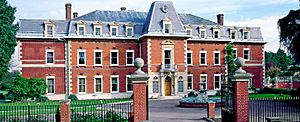Arthur Moore (Grimsby MP) facts for kids
Arthur Moore (born around 1666 – died May 4, 1730) was an important Irish businessman and politician. He was a member of the English and British House of Commons from 1695 to 1722. He was known for his work in economics and was a member of the Tory political party. He lived at Fetcham Park in Surrey, England.
Contents
Life of Arthur Moore
Arthur Moore was likely born in Monaghan, Ireland, around 1666. He started his career as an adventurer. He quickly learned about trade and made a lot of money.
Becoming a Member of Parliament
In 1695, Arthur Moore was elected to Parliament for Great Grimsby in Lincolnshire. He represented this area from 1695 to 1715. He was elected again in 1721. In 1722, he lost his seat in Grimsby. He also had a house in Grimsby and was a high steward of the town from 1714 until his death.
Business and Government Roles
In 1702, Moore was involved with the "united trade to the East Indies." This was a big trading company. He also became a director of the South Sea Company. This was another major trading company. In 1704, he was made comptroller of the army accounts. This meant he helped manage the army's money. In 1710, he became a lord commissioner of trade and plantations. He held this important job for the rest of Queen Anne's rule.
Political Influence
During Queen Anne's last years, Arthur Moore was very skilled in Parliament. He was seen as a very capable person. His brother, Thomas Moore, also held an important government job. Arthur Moore tried to help settle arguments between two powerful politicians, Robert Harley, 1st Earl of Oxford and Henry St John, 1st Viscount Bolingbroke. Later, he supported Robert Walpole, who became a very important leader.
Moore helped create parts of the trade agreements with France and Spain in 1712. He wanted to include free trade rules, but these were later removed. This made some people, especially the Whig party in London, dislike him.
In 1714, some people claimed that Moore was involved in a special contract called the Assiento. This contract was about trading slaves. The directors of the South Sea Company looked into these claims. In July 1714, the company criticized him. They said he was involved in secret trade that hurt the company. Because of this, he was not allowed to work for the company anymore.
Arthur Moore bought several properties in Surrey, England. These included Fetcham Park House, the Randalls estate in Leatherhead, and a farm called Polesden in Great Bookham. However, he spent money very freely. His house was designed by a famous architect named Talman. It was decorated by Louis Laguerre. Arthur Moore passed away on May 4, 1730. He was buried at Fetcham. A sculptor named Thomas Carter made a statue of him.
Family
Arthur Moore married Susanna Browne in London in 1692. They had two daughters, but they both died when they were very young. Susanna passed away in 1695.
In 1696, Arthur Moore married his second wife, Theophila Smythe, at Westminster Abbey. She was about 20 years old at the time. Theophila lived until 1739. They had three sons and three daughters. Their first son was William Moore, who also became a Member of Parliament. Their third son was James Moore Smythe.


